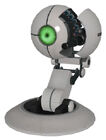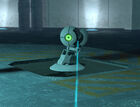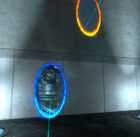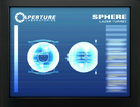| This article is within the scope of the Portal Project, a collaborative effort to improve articles related to Portal and Portal 2. See the project page for more details about the article status. |
| You can help by correcting spelling and grammar, removing factual errors, rewriting sections to ensure they are clear and concise, and moving some elements when appropriate. Visit our Cleanup Project for more details and, please, notify the administrators before removing this template. |
The Rocket Sentry is a static rocket-firing gun platform that is based on a Personality Construct and used in the Aperture Science Enrichment Center.
Apparently used within the facility as a security mechanism, it is eventually used by Chell to defeat GLaDOS in the Central AI Chamber at the end of Portal.
Overview[]
- Rocket Sentry turrets consist of what appears to be a Personality Core mounted atop a robotic arm that retracts in the ground, only leaving the top of the Personality Core visible. When activated, the Core's left panel slides out so a rocket launcher and sensory device that emits a blue-green laser for targeting are revealed. In addition, the Personality Core "eye" is used to indicate the current status of the turret by color:
- Green = idle.
- Yellow = locked on target.
- Red = firing the rocket.
- The Rocket Sentry, either by the virtue of being mounted to the floor or having a highly effective armor, is unable to be destroyed by Chell. For instance, if one places a portal behind and in front of a Rocket Sentry and make it fire into the portals, the rocket will fly through the portals until it hits the Rocket Sentry, and vaporize without making any damage, with effects similar to when an object is thrown in a Material Emancipation Grill.
- Only two Rocket Sentries are found within the Aperture Laboratories. One among abandoned offices and activated by a small red button, and another in GLaDOS' chamber. It is unknown if they are used in Test Chambers or other locations.
- When activating, the rockets slide down towards the barrel before the laser is set up. When locking on, one rocket is removed from the rack and loaded into the barrel, then fired.
Tactics[]
- After locking on, the Rocket Sentry will always pause briefly, emit a loud electronic beep and its eye turns yellow, and then fires a single rocket after its eye turns from yellow to red.
- Rocket Sentries do not seem to be programmed to track targets since they will launch their rocket even if the target has moved. Thanks to this, Chell can "trick" Rocket Sentries into breaking objects hindering her path such as windows, a Pipe Network pipe, and GLaDOS herself, detaching one of her Personality Cores with every rocket.
- A direct hit from a rocket will be deadly to Chell. However, she can use simple objects found around the Enrichment Center to completely shield herself from taking any damage and use portals to redirect the rockets. Also, rockets have a lower velocity than Sentry Turrets' bullets, making it slightly easier to dodge but slightly harder to hit GLaDOS during the final battle when she is not stationary.
Behind the scenes[]
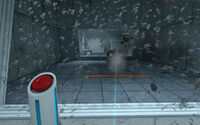
The office Rocket Sentry firing, shattering the first glass.
- As stated by Bill Van Buren, this Sentry originally fired lasers. The team switched from lasers to rockets after they introduced the glass-breaking mechanic, mainly because glass shattering in a massive rocket explosion turned out to be a lot more satisfying than glass just slowly being melted by a laser.[1]
- The lasers were also considered boring to dodge. Aiming with them was also considered difficult, and it was hard to tell when the player was hit.[2]
- Originally, the Rocket Sentry also spoke, just like the Sentry Turret. However, because players often redirect the rockets with their backs to the Rocket Sentry, a distinct, uncluttered sound cue was required. The voice simply added too much noise to the rocket redirect mechanic.[1]
- As stated by Realm Lovejoy, breaking the Pipe Network tube with the office Rocket Sentry gives players a chance to test out their newly trained rocket-redirecting and glass-breaking skills in a slightly different context, which helps cement the training.[1]
- The rockets were originally weaker and could not kill Chell in a direct hit.
- The Personality Core used by the Rocket Sentry possibly relies on a rudimentary targeting system, as it must acquire a lock-on, giving it a delay before it could fire a slow-moving rocket. This effectively eliminates all of its accuracy as it either fires and misses, or does not fire at all.
- The rocket sentry originally had a successor in Portal 2, named the Hover Turret. In the game's files, there are leftovers of the rocket sentry's personality core being scanned by the tubes as a "laser turret", implying that the rocket sentries were meant to fly, but equipped with lasers instead. The hover turret was removed from the game, but its NPC still exists.
Trivia[]
- The Rocket Sentry's model is ragdolled, suggesting that at some point it was meant to be destroyed. The ragdoll, however, is unfinished and constantly collides with itself.
- The Rocket Sentry will not shoot at NPCs when spawned from the console, as the normal course of the game does not allow it.
- If a Sentry Turret is spawned through console commands, it will attack any fired rockets.
- The Rocket Sentry is not affected by the console command "ai_disable", which disables the AI of NPCs.
- The Rocket Sentry's laser sight is similar to that of an Overwatch Sniper and may have been a reused asset.
- The first Rocket Sentry encountered will activate if the glass panels surrounding it are shot using the impulse_101 cheat.
Gallery[]
Portal[]
Portal 2[]
Pre-release[]
List of appearances[]
- Portal (First appearance)
- Portal: Still Alive (Non-canonical appearance)
- Portal 2 (Game files only)
References[]
- ↑ 1.0 1.1 1.2 Portal commentary
- ↑ Integrating Narrative and Design: A Portal Post-Mortem by Kim Swift and Erik Wolpaw

